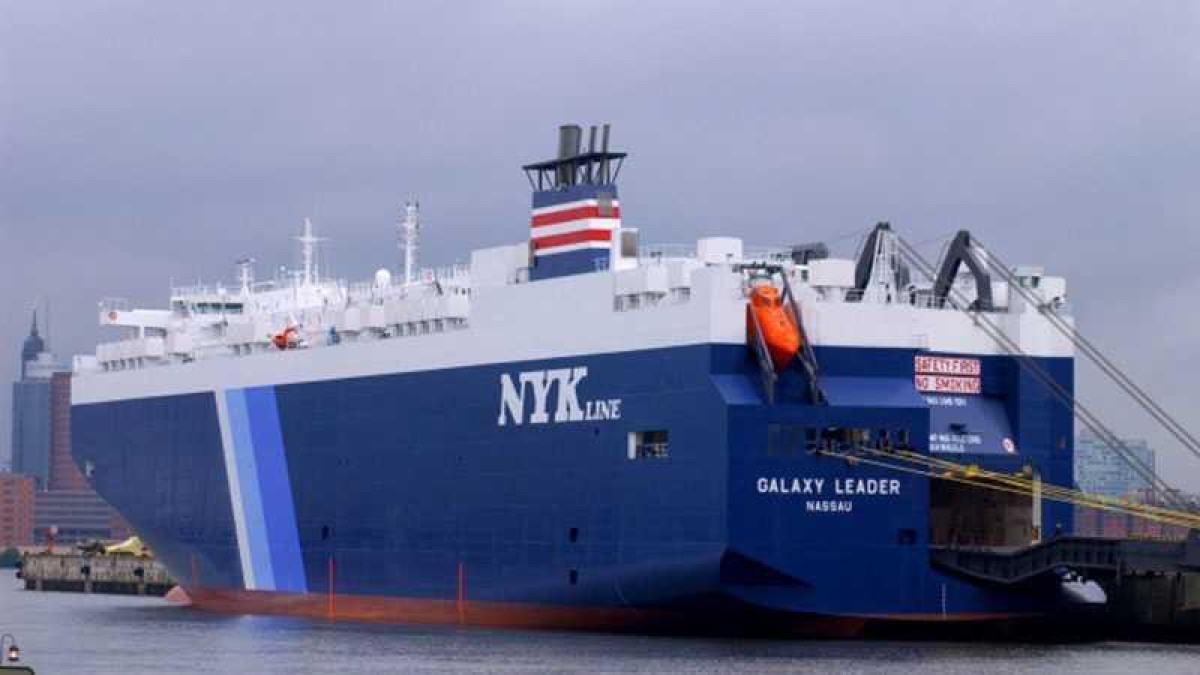A New Phase: Exploring the Aftermath of the Houthi Seizure of the GALAXY LEADER Ship
- 23 Nov 2023


On November 19, 2023, the Houthi militia heightened tensions with Israel by seizing the "Galaxy Leader" vehicle carrier in the Red Sea, redirecting it to a Yemeni port, thereby escalating the conflict to a new level. This move followed Israeli military operations in the Gaza Strip, initiated in response to the "Al-Aqsa Flood" operation conducted by the Al-Qassam Brigades, the military arm of the Hamas movement, within the Gaza envelope on October 7 of the preceding year.
The prior engagement in this escalation was confined to using ballistic missiles and drones intercepted by air defence systems. Significantly, for the first time since the commencement of the ongoing war in the Gaza Strip, the Houthi militia adopted this new approach to managing the conflict with Israel. It appears that in the latter stages, the militia aimed to anticipate Israel's responses to the escalating situation and assess the potential extent of the conflict. Consequently, it deliberately heightened the level of this escalation when faced with no immediate counter-response from Israel. This tactic bears similarity to Israel's actions when launching military attacks against pro-Iranian militias in Lebanon, Syria, and Iraq.
Despite Israel's persistent denial of ownership and claims that the seized ship is not associated with any Israelis or Israeli entities (despite reports suggesting otherwise, linking it to an Israeli business person), the intended message from the Houthis appears to have effectively reached its objective. This message conveys that if the ballistic missiles and drones launched by the Houthis towards Israel in recent times have not inflicted human or material losses—given that most were intercepted before reaching their targets—the militia possesses alternative methods to target influential or vital Israeli assets. The hijacking of cargo ships, as demonstrated in the latest operation following the threat made by militia leader Abdul-Malik al-Houthi, serves as a tangible example of this alternative mechanism.
This action reflects a specific alignment with the strategies employed by Iran in managing its indirect escalation with Israel in the period leading up to the current conflict in the Gaza Strip. Iran responded to Israeli intelligence operations within its nuclear and military facilities by targeting Israeli cargo ships in the waters near Yemen. The objective was to increase the cost of these operations, which Iran directly attributed to the Mossad. These operations resulted in significant damage to critical nuclear facilities, including the Natanz uranium enrichment facility, subjected to successive attacks on July 2, 2020, and April 12, 2021, as well as the targeted assassinations of nuclear scientists. One such instance was the killing of Mohsen Fakhrizadeh, the head of the Research and Development Institution in the Iranian Ministry of Defense, on November 27, 2020
The Pivotal Arena
This qualitative escalation, potentially ushering in a new stage in the confrontation between the Houthi militia, Israel, and the United States of America, underscores a critical observation. Among the countries housing armed militias aligned with Iran, Yemen emerges as the probable battleground for heightened tensions with Israel and the United States, surpassing countries like Lebanon, Syria, and Iraq. Three primary considerations elucidate this observation:
1- The Militia's Perception of its Yemeni Power Dynamics:
The Houthi militia perceives itself as a governing entity, not an organisation. This self-perception implies that, according to their claims, they represent a state or at least a government with decision-making independence in managing domestic and international affairs of particular concern. Allegedly, the militia is not subject to internal or external pressures to control the escalation level with Israel. Moreover, its considerable geographical distance from the theatre of operations (approximately 2,000 kilometres) provides broader options and increased freedom of movement in managing the escalation with Israel compared to other militias.
2- Distinctive Role of the Militia in the Iranian Network:
The Houthi militia's position within the Yemeni power structure endows it with a certain exclusivity compared to other armed militias loyal to Iran. While Lebanese Hezbollah holds a pivotal role among Iran's agents due to its formidable military capabilities and experience, it lacks the range of options available to the Houthi militia. Hezbollah faces internal pressure due to its involvement, at Iran's behest, in the Syrian conflict alongside President Bashar al-Assad's forces since the conflict's outbreak in March 2011. This participation violates Lebanon's "distancing" policy regarding developments in the Syrian conflict. Furthermore, Hezbollah has been accused of contributing to the presidential vacuum crisis in Lebanon. Its proximity to the theatre of operations potentially enables Israel to raise the cost of any attempt by Hezbollah to escalate, possibly surpassing the destruction witnessed in the 2006 war between the party and Israel.
Unlike the Houthi militia, pro-Iranian militias in Syria and Iraq face limitations in expanding the scope of escalation with Israel. Their decision-making is not solely tied to the Israel escalation but also relates to the confrontation with the United States. The U.S. has increased its military presence near the theatre of operations, deploying two aircraft carriers, the "USS Gerald R. Ford" and "USS Eisenhower." The U.S. has threatened to respond to attacks on its military bases in Iraq and Syria, and it has begun implementing this threat by targeting two sites belonging to the Iranian Revolutionary Guard in the Syrian Albukamal region on October 27.
3. Long-Term Ramifications of the Ship Hijacking:
The Houthi militia's hijacking of the "Galaxy Leader" cargo ship may not be without a calculated objective—to influence the stance adopted by international powers concerning the ongoing Israeli military escalation in the Gaza Strip. The militia claims to be the sole entity among Iran's proxies capable of threatening global shipping traffic, leveraging Yemen's proximity to crucial international transportation routes in Bab al-Mandab and the Red Sea.
In contemplating this move, the militia likely anticipates that, unless met with a robust response, it could set a precedent leading to additional similar actions, thereby incurring a global cost. This cost might extend beyond the heightened insurance fees for worldwide commercial traffic, much of which traverses Bab al-Mandab and the Red Sea. It could potentially escalate to impact energy prices in the foreseeable future. This variable introduces substantial pressure on international powers, particularly Western nations, reminiscent of the crisis that unfolded in the aftermath of the Russian-Ukrainian war commencing on February 24, 2022. During that conflict, Russia's interruption of energy supplies to European countries prompted a significant crisis.
It serves as a stark reminder of the Houthi militia's alignment with Iran, which has previously issued threats to disrupt global trade movements in various critical maritime chokepoints, including the Strait of Hormuz, Bab al-Mandab, and the Red Sea. These threats were made in response to the imposition of sanctions by the U.S. on August 7, 2018, following its withdrawal from the nuclear agreement on May 8 of the same year. These sanctions initially led to a notable decline in Iranian oil exports, although Iran later managed to circumvent them, subsequently gradually elevating these exports once again.
Conditional Escalation
Given the developments above, the recent escalation initiated by the Houthi militia might pave the way for subsequent actions, with the trajectory contingent on a pivotal variable—the responses of the involved entities.
These entities will likely consider two primary courses of action in this context. Firstly, they may reinstate the previous approach, aiming to mitigate or neutralise the adverse consequences of the Houthi escalation. This approach mirrors the last phase, characterised by defensive measures against Houthi attacks, suggesting that the entities may intensify military operations near global transportation routes to thwart the militia's potential repetition of such operations.
Secondly, there is the possibility of directing military strikes against the Houthi militia, akin to responses to other armed militias. While Israel remains a potential actor in this scenario, the involvement of the United States of America is conceivable. The hijacking's potential repercussions extend beyond Israel's interests, encompassing those of significant powers.
Undoubtedly, the Houthi militia is weighing both options and appears poised to shape its next move based on the chosen course of action by the involved entities. Iran's calculations are integral to this context, as the militia's actions likely received tacit approval from Tehran. Despite Tehran's disavowal of orchestrating the escalation between Israel and its proxies and its rejection of Israeli Prime Minister Benjamin Netanyahu's characterisation of the Houthi move as an "Iranian kidnapping," it remains intertwined with the ongoing dynamics in the region.
The stated views express the views of the author and do not necessarily reflect the views of the Center or the work team.
Comments